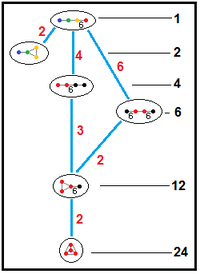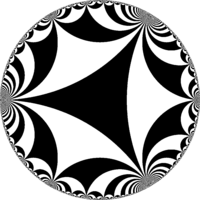Order-6 tetrahedral honeycomb
| Order-6 tetrahedral honeycomb | |
|---|---|
 Perspective projection view within Poincaré disk model | |
| Type | Hyperbolic regular honeycomb Paracompact uniform honeycomb |
| Schläfli symbols | {3,3,6} {3,3[3]} |
| Coxeter diagrams | |
| Cells | {3,3} |
| Faces | Triangle {3} |
| Edge figure | Hexagon {6} |
| Vertex figure | Triangular tiling {3,6}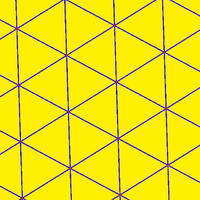  |
| Dual | Hexagonal tiling honeycomb, {6,3,3} |
| Coxeter groups | , [6,3,3] , [3,3[3]] |
| Properties | Regular, quasiregular |
In the geometry of hyperbolic 3-space, the order-6 tetrahedral honeycomb is a paracompact regular space-filling tessellation (or honeycomb). It is called paracompact because it has infinite vertex figures, with all vertices as ideal points at infinity. With Schläfli symbol {3,3,6}. It has six tetrahedra {3,3} around each edge. All vertices are ideal vertices with infinitely many tetrahedra existing around each ideal vertex in an triangular tiling vertex arrangement.[1]
A geometric honeycomb is a space-filling of polyhedral or higher-dimensional cells, so that there are no gaps. It is an example of the more general mathematical tiling or tessellation in any number of dimensions.
Honeycombs are usually constructed in ordinary Euclidean ("flat") space, like the convex uniform honeycombs. They may also be constructed in non-Euclidean spaces, such as hyperbolic uniform honeycombs. Any finite uniform polytope can be projected to its circumsphere to form a uniform honeycomb in spherical space.
Symmetry constructions
It has a second construction as a uniform honeycomb, Schläfli symbol {3,3[3]}, with alternating types or colors of tetrahedral cells. In Coxeter notation the half symmetry is [3,3,6,1+] ↔ [3,((3,3,3))] or [3,3[3]]: ![]()
![]()
![]()
![]()
![]()
![]()
![]() ↔
↔ ![]()
![]()
![]()
![]()
![]() .
.
Related polytopes and honeycombs
It is similar to the 2-dimensional hyperbolic tiling, infinite-order triangular tiling, {3,∞}, having all triangle faces, and all ideal vertices.
Related regular honeycombs
It is one of 15 regular hyperbolic honeycombs in 3-space, 11 of which like this one are paracompact, with infinite cells and/or infinite vertex figures.
| 11 paracompact regular honeycombs | |||||||||||
|---|---|---|---|---|---|---|---|---|---|---|---|
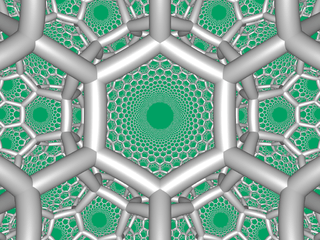 {6,3,3} |
 {6,3,4} |
 {6,3,5} |
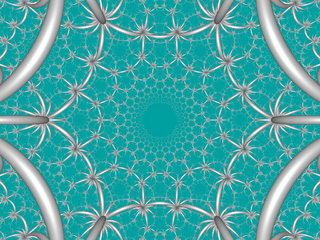 {6,3,6} |
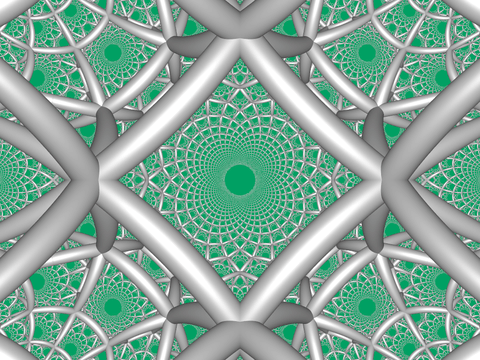 {4,4,3} |
 {4,4,4} | ||||||
 {3,3,6} |
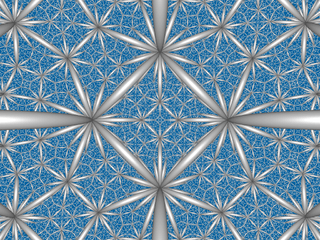 {4,3,6} |
 {5,3,6} |
 {3,6,3} |
 {3,4,4} | |||||||
633 honeycombs
It is one of 15 uniform paracompact honeycombs in the [6,3,3] Coxeter group, along with its dual hexagonal tiling honeycomb, {6,3,3}.
| [6,3,3] family honeycombs | |||||||||||
|---|---|---|---|---|---|---|---|---|---|---|---|
| {6,3,3} | r{6,3,3} | t{6,3,3} | rr{6,3,3} | t0,3{6,3,3} | tr{6,3,3} | t0,1,3{6,3,3} | t0,1,2,3{6,3,3} | ||||
 |
 |
 |
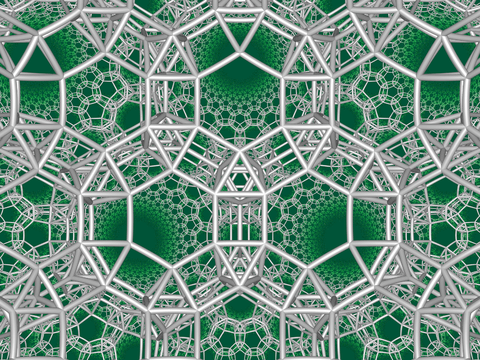 |
 |
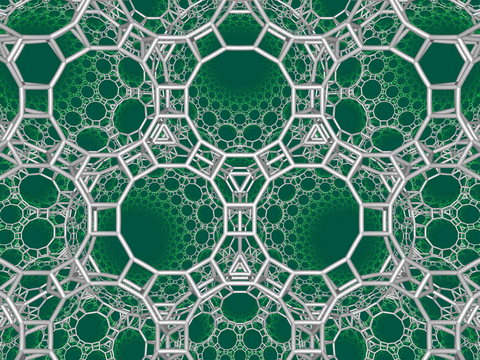 |
 |
 | ||||
 |
 |
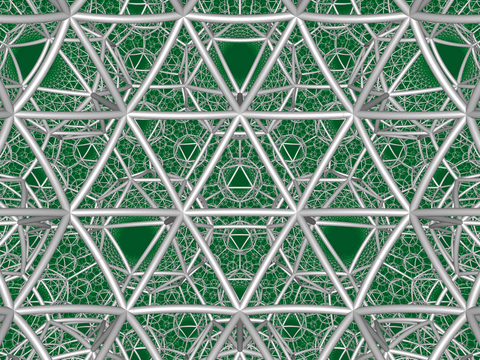 |
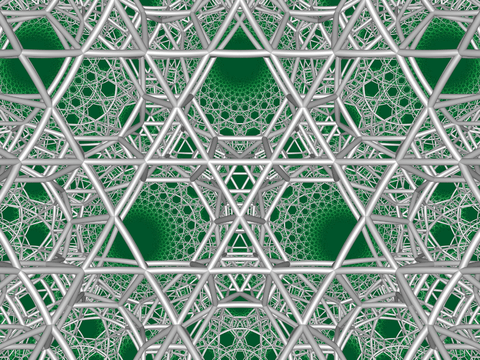 |
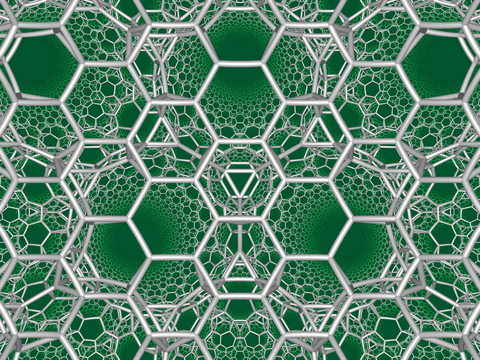 |
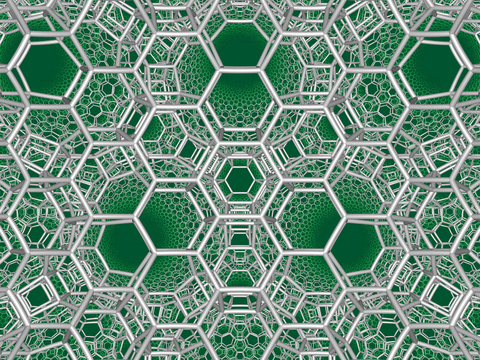 |
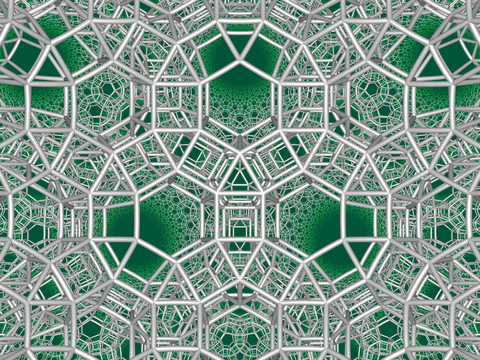 | |||||
| {3,3,6} | r{3,3,6} | t{3,3,6} | rr{3,3,6} | 2t{3,3,6} | tr{3,3,6} | t0,1,3{3,3,6} | t0,1,2,3{3,3,6} | ||||
Tetrahedral cell honeycombs
It a part of a sequence of regular polychora and honeycombs with tetrahedral cells.
| {3,3,p} polytopes | |||||||||||
|---|---|---|---|---|---|---|---|---|---|---|---|
| Space | S3 | H3 | |||||||||
| Form | Finite | Paracompact | Noncompact | ||||||||
| Name | {3,3,3} |
{3,3,4} |
{3,3,5} |
{3,3,6} |
{3,3,7} |
{3,3,8} |
... {3,3,∞} | ||||
| Image | 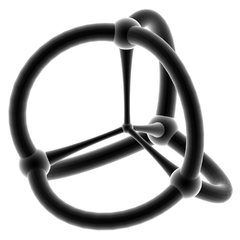 |
 |
 |
 |
 |
 |
 | ||||
| Vertex figure |
 {3,3} |
 {3,4} |
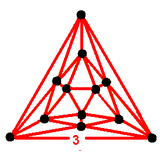 {3,5} |
 {3,6} |
 {3,7} |
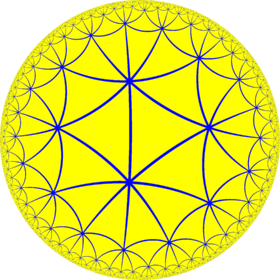 {3,8} |
 {3,∞} | ||||
Triangular tiling vertex figures
It a part of a sequence of honeycombs with triangular tiling vertex figures.
| Form | Paracompact | Noncompact | |||||
|---|---|---|---|---|---|---|---|
| Name | {3,3,6} {3,3[3]} |
{4,3,6} {4,3[3]} |
{5,3,6} {5,3[3]} |
{6,3,6} {6,3[3]} |
{7,3,6} {7,3[3]} |
{8,3,6} {8,3[3]} |
... {∞,3,6} {∞,3[3]} |
| Image |  |
 |
 |
 |
|||
| Cells | {3,3} |
{4,3} |
{5,3} |
{6,3} |
{7,3} |
{8,3} |
{∞,3} |
Rectified order-6 tetrahedral honeycomb
| Rectified order-6 tetrahedral honeycomb | |
|---|---|
| Type | Paracompact uniform honeycomb Semiregular honeycomb |
| Schläfli symbols | r{3,3,6} or t1{3,3,6} |
| Coxeter diagrams | |
| Cells | {3,4} {3,6} |
| Vertex figure |  Hexagonal prism { }×{6} |
| Coxeter groups | , [6,3,3] , [3,3[3]] |
| Properties | Vertex-transitive, edge-transitive |
The rectified order-6 tetrahedral honeycomb, t1{3,3,6} has octahedral and triangular tiling cells connected in a hexagonal prism vertex figure.
-


Perspective projection view within Poincaré disk model
| Space | H3 | ||||||
|---|---|---|---|---|---|---|---|
| Form | Paracompact | Noncompact | |||||
| Name | r{3,3,6} |
r{4,3,6} |
r{5,3,6} |
r{6,3,6} |
r{7,3,6} |
... r{∞,3,6} | |
| Image |  |
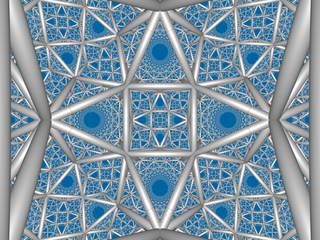 |
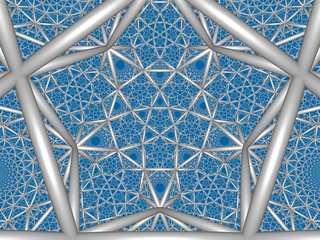 |
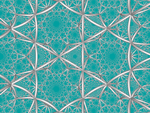 |
|||
| Cells {3,6} |
r{3,3} |
r{4,3} |
r{6,3} |
r{6,3} |
r{∞,3} |
r{∞,3} | |
Truncated order-6 tetrahedral honeycomb
| Truncated order-6 tetrahedral honeycomb | |
|---|---|
| Type | Paracompact uniform honeycomb |
| Schläfli symbols | t{3,3,6} or t0,1{3,3,6} |
| Coxeter diagrams | |
| Cells | t{3,3} {3,6} |
| Vertex figure |  Hexagonal pyramid { }v{6} |
| Coxeter groups | , [6,3,3] , [3,3[3]] |
| Properties | Vertex-transitive |
The truncated order-6 tetrahedral honeycomb, t0,1{3,3,6} has truncated tetrahedra and triangular tiling cells connected in a hexagonal prism vertex figure.

Bitruncated order-6 tetrahedral honeycomb

Cantellated order-6 tetrahedral honeycomb
| Cantellated order-6 tetrahedral honeycomb | |
|---|---|
| Type | Paracompact uniform honeycomb |
| Schläfli symbols | rr{3,3,6} or t0,2{3,3,6} |
| Coxeter diagrams | |
| Cells | r{3,3} r{3,6} {}x{6} |
| Vertex figure |  tetrahedron |
| Coxeter groups | , [6,3,3] , [3,3[3]] |
| Properties | Vertex-transitive |
The cantellated order-6 tetrahedral honeycomb, t0,2{3,3,6} has cuboctahedron and trihexagonal tiling cells connected in a tetrahedron vertex figure.

Cantitruncated order-6 tetrahedral honeycomb
| Cantitruncated order-6 tetrahedral honeycomb | |
|---|---|
| Type | Paracompact uniform honeycomb |
| Schläfli symbols | tr{3,3,6} or t0,1,2{3,3,6} |
| Coxeter diagrams | |
| Cells | tr{3,3} r{3,6} {}x{6} |
| Vertex figure |  tetrahedron |
| Coxeter groups | , [6,3,3] , [3,3[3]] |
| Properties | Vertex-transitive |
The cantitruncated order-6 tetrahedral honeycomb, t0,1,2{3,3,6} has truncated cuboctahedron and trihexagonal tiling cells connected in an octahedron vertex figure.

See also
References
- ↑ Coxeter The Beauty of Geometry, 1999, Chapter 10, Table III
- Coxeter, Regular Polytopes, 3rd. ed., Dover Publications, 1973. ISBN 0-486-61480-8. (Tables I and II: Regular polytopes and honeycombs, pp. 294–296)
- The Beauty of Geometry: Twelve Essays (1999), Dover Publications, LCCN 99-35678, ISBN 0-486-40919-8 (Chapter 10, Regular Honeycombs in Hyperbolic Space) Table III
- Jeffrey R. Weeks The Shape of Space, 2nd edition ISBN 0-8247-0709-5 (Chapter 16-17: Geometries on Three-manifolds I,II)
- Norman Johnson Uniform Polytopes, Manuscript
- N.W. Johnson: The Theory of Uniform Polytopes and Honeycombs, Ph.D. Dissertation, University of Toronto, 1966
- N.W. Johnson: Geometries and Transformations, (2015) Chapter 13: Hyperbolic Coxeter groups
